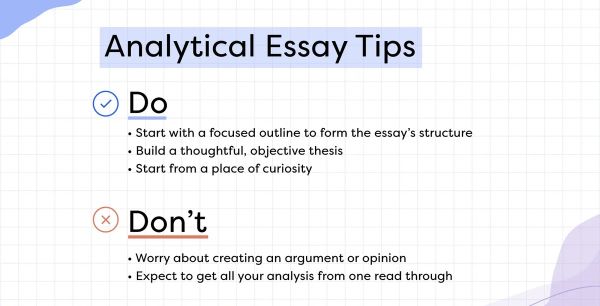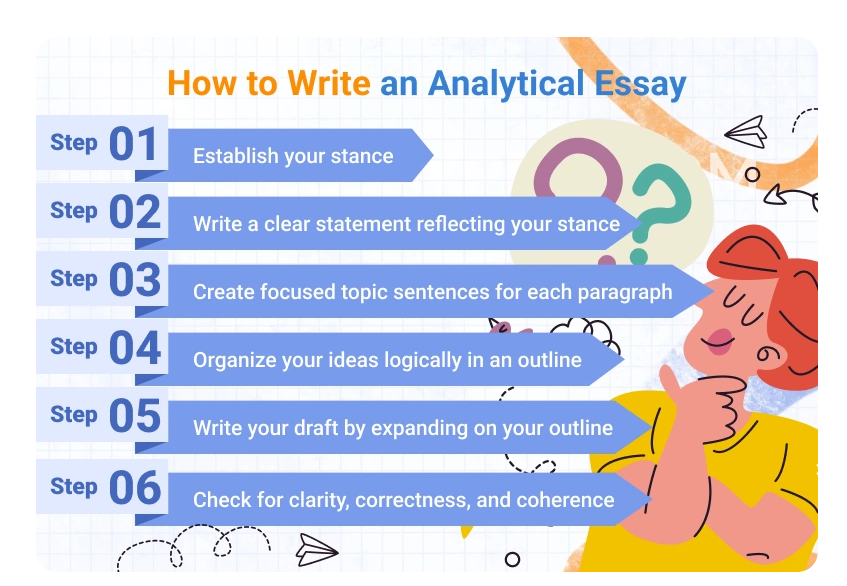
If you enjoy thinking critically and deeply, using an analytical essay can be the perfect tool. Analytical essays use thorough analysis and intelligent writing techniques to gain fresh perspectives and deepen the understanding of the subject. In this blog, we will provide information regarding analytical essays, their structure, and examples of analytical essays.
What is an analytical essay?
An analytical essay helps analyze various topics, such as movies, ideas, or books. Analytical essays depend on evidence from tests to support their argument logically and do not consider emotional appeals and personal stories. The perspective essays, on the other hand, argue in favour of a particular viewpoint. A good-quality analytical essay investigates all the aspects of the subject by considering all the perspectives and arguments and analyzing the evidence carefully. Ultimately, it is important to mention your stance based on the analysis made and decide whether you agree with the conclusion or have any other opinion.

What Sets an Analytical Essay Different from a Descriptive Essay?
The author's perspective is what distinguishes an analytical essay from a descriptive one. Descriptive essays typically take the shape of book summaries, movie synopses, descriptive articles, and informational pamphlets that lack analysis or opinion, whereas analytical essays offer an argument backed by facts. A solid descriptive essay will employ logical transitions, the group-provided subjects into body paragraphs, and emphasize its important arguments, just like a good analytical essay. But in the end, analytical essays explore interpretation, whereas descriptive essays provide a summary of the facts.
Structure of an Analytical Essay
To create an attractive and informative analytic essay, it is important to begin with a clear organization and structuring of the arguments in the essay. The structure of an analytical essay is straightforward and consists of an introduction, body paragraphs, and a conclusion.
- Introduction: It is the first part of the research study and is important in grabbing the attention of the readers and starting the topic. The introduction should contain the background, the purpose of the paper, and a few hints regarding the arguments you made. The opening sentence of the introduction should be engaging and can contain any surprising fact or any thought-provoking statement. The introduction should conclude with the thesis and your stance in the essay.
- Body paragraphs: Every body paragraph should start with a topic sentence that will guide the reader and provide evidence in support of the thesis. Every paragraph should contain one issue and end with the main point to smoothly transition to the next paragraph. This helps to provide clarity and coherence in the arguments made.
- Conclusion: Here, the author is required to restate the thesis statement by summarizing the key points from the different body paragraphs and providing information on the importance of the analysis. The author should provide information regarding the importance of the topic and the way the analysis further contributes to the topic. This helps in creating a long-lasting impression in the minds of the readers.
Steps for Writing an Analytical Essay

Analytical essay in easy steps
After gaining knowledge of the structure, writing an analytical essay is very easy by following the six simple steps. Preparing in advance can make the essay writing process more smooth and improve the overall flow of the essay. Some of the important tips that can help in writing a high-quality analytical essay are
Step 1: Deciding a stance: Before starting the writing, it becomes important to establish a stance on the topic. For instance, if the analytical essay is written on the benefits and drawbacks of remote work, it is important to decide your opinion regarding the topic.
After deciding your stance on remote work, it is necessary to provide the evidence and arguments that support your stand in the essay. The use of statistics and data is also very important in showcasing the improved productivity of employees working remotely. However, if you think it results in isolation, then you can provide information regarding surveys showcasing the changes due to remote working. The opinion of the author plays an important role in shaping the essay. Therefore, it is important to think before taking a stance in the analytical essay.
Step 2: Writing the thesis statement
After deciding the stance on the topic, it is important to write the thesis statement of the essay. The thesis statement acts as the main idea for the essay. If you think that remote working is beneficial for the employees, then the thesis statement should be like, “Remote working will help in improving the performance of the employees by providing work-life balance for them.”.
On the other hand, if you believe remote working has too many drawbacks, then the thesis statement should be “Although remote working provides flexibility, it has many drawbacks, such as employee isolation and challenges in collaboration.”.
The thesis statement is very crucial as it helps guide the analytical essay by clearly expressing the viewpoint on the benefits and challenges of remote working.
Step 3: Topic sentence
After writing the thesis statement on the benefits or drawbacks of remote working, it is time to write the topic sentence for each paragraph in the analytical essay. The topic sentences introduce the main points of the paragraph and improve the structure of the essay.
For instance, if the first paragraph is about one of the benefits of remote working, then the topic sentence in the first paragraph should be “Remote working provides great flexibility to the employees and helps them in better managing their work.
If the next paragraph discusses the challenges of remote working, then the topic sentence should be like, “Although remote working can result in creating a feeling of isolation among the employees.”.
In the next paragraph, providing solutions to the challenges of remote work, the topic sentence could start with “To reduce the drawbacks of remote working, the companies can make use of strategies such as regular check-ins, team-building activities, and flexible work schedules.
Every topic sentence should be related to the thesis statement, regarding the benefits and challenges of remote working, and provide focus on the next paragraph.
Step 4: Creating an outline
After the creation of the thesis statement and topic sentence, it is important to create an analytical essay outline that can help make the essay flow logically. The following outline is based on the benefits and challenges of remote working:
| Introduction | Provide a background opinion. Provide the thesis statement. |
| Benefits of remote working | Topic sentence: Remote work helps in improving the flexibility of the employees. Provide details and examples. |
| Challenges of remote working | Topic sentence: On the other hand, remote working leads to employee isolation and collaboration. Provide details and examples. |
| Solutions to the challenges of remote working | Topic sentence: To reduce the challenges, companies can make use of various strategies. Provide details and examples. |
| Conclusion | Summarize the main points. Restate the thesis statement. Provide closing statements and recommendations. |
Step 5: Writing the draft
After the preparation of the outline, it is time to start the first draft. The draft should begin with the expansion of each point in the outline and smoothly and logically connect the ideas. Perfection is not important during this stage, as the only purpose of this stage is to get the ideas on paper. The draft can always be polished and refined at later stages. When writing the draft, it is important to continuously refer back to the thesis statement to make sure that the arguments align with the main argument of the analytical essay. Additionally, it is important to note that the paragraph flows naturally in the essay, which helps in maintaining the coherence of the essay.
As writing is a process, making multiple drafts is important as it helps in creating a perfect result.
Step 6: Revise and proofread
After the completion of the draft, it is important to revise and proofread the essay for coherence, clarity, and correctness. Steps in proofreading include:
- Make sure the idea and points align with the main argument of the analytical essay.
- It is important to make sure that the writing style and format are the same throughout the essay and to follow the rules and regulations of the essay.
- Double-check the facts to make sure that you have covered all the points of the essay.
- Delete the extra words to make the sentences precise and clear.
- Locate the grammatical and spelling mistakes.
- Ask someone to read the essay and provide feedback.
Conclusion
The tips provided in the essay will help boost the crafting and writing skills, which will help in captivating the audiences of the essays. Practising analytical writing can help improve your writing skills and help you face any topic with confidence. However, if you need any kind of help with assignment writing, then our experts at The Assignment Ninjas can be very helpful.


